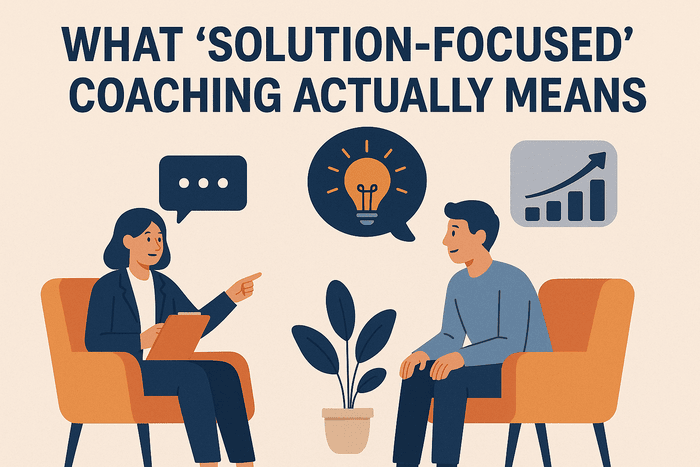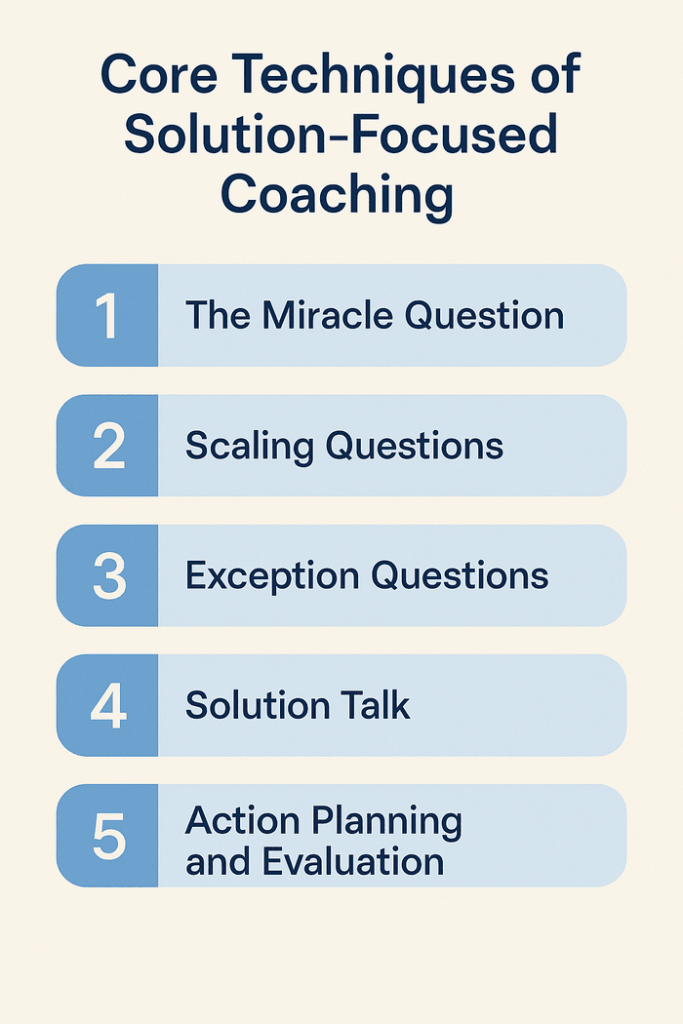
India’s economy has transformed dramatically over the last decade, and the demand for top business coach India services has grown...
Coaching is full of jargon. Terms like transformational, holistic and solution‑focused are liberally sprinkled across marketing materials. But when clients ask, “What does solution‑focused coaching actually mean?”, many coaches struggle to go beyond a vague promise of positive thinking. This article demystifies the solution‑focused approach. We will examine its origins in psychology, explore the core techniques that differentiate it from other coaching models, discuss when and how to apply it, and highlight both its strengths and limitations. Whether you are a coach looking to expand your toolkit or a client considering this method, understanding the methodology behind the buzzword is crucial.

The solution‑focused model emerged in the 1980s as an offshoot of family therapy. Rather than dwelling on past traumas and diagnostic labels, the founders – Steve de Shazer and Insoo Kim Berg – asked a radical question: What if we help people move forward by focusing on their strengths and exceptions rather than analysing their problems? In the field of psychotherapy this approach became known as solution‑focused brief therapy (SFBT). In essence, SFBT places far more importance on discussing solutions than problems . While clients must identify what is troubling them, sessions quickly pivot to defining a desired future and taking concrete steps toward it. This present‑and‑future orientation frees clients from the paralysis of over‑analysing the past .
In coaching, the core principles of SFBT are adapted for performance and personal development contexts. Solution‑focused coaching emphasises identifying and building on strengths . It empowers clients to envision and create their preferred future, rather than becoming bogged down in the details of what went wrong . The approach is succinct – sometimes referred to as brief – because it aims to help clients achieve results quickly rather than engaging in endless analysis . Although developed in the context of therapy, solution‑focused coaching has found applications in business, education, sports and personal growth.
Traditional coaching models often draw from behavioural psychology or cognitive‑behavioural therapy. They emphasise identifying limiting beliefs, analysing root causes and correcting cognitive distortions. While these methods can be powerful, they may inadvertently reinforce a problem‑focus. In contrast, solution‑focused coaching works by evaluating an individual’s current situation and leveraging existing strengths and resources . It reframes issues into small, realistic steps that can be taken to find the most suitable solution . Instead of delving into why a problem exists, the coach asks, When is the problem less intense? What is different in those moments? These questions shift attention to exceptions and successes.
Solution‑focused coaching also assumes that clients are the experts on their own lives. The coach’s role is not to diagnose or prescribe but to facilitate a process that helps clients discover their own solutions. This contrasts with more directive models where the coach may teach specific tools or provide advice. A solution‑focused coach therefore prioritises curiosity, powerful questions, and confidence in the client’s agency.
One of the hallmarks of the solution‑focused approach is its structured, goal‑oriented process. According to the Coach Foundation’s overview of the solution‑focused coaching model, the methodology includes four distinct phases: goal orientation, developing clarity, action plan accuracy and evaluation planning . In the goal orientation phase the coach and client define realistic objectives and measurable outcomes. Developing clarity involves exploring possible options and increasing mutual understanding of the desired future . During the action plan phase, specific steps are created to reach the goals. Finally, evaluation planning sets criteria and methods for measuring progress so that adjustments can be made .
This continuous feedback loop distinguishes solution‑focused coaching from more open‑ended models. By checking progress at regular intervals and measuring outcomes, clients stay motivated and can see tangible evidence of change.

Although the philosophy of solution‑focused coaching is straightforward, the model is supported by a toolkit of structured techniques. These methods help clients articulate a compelling future vision, identify resources and maintain momentum.
One of the most famous tools in solution‑focused coaching is the Miracle Question. It invites clients to imagine that during the night, a miracle occurred and the presenting problem was resolved. Upon waking, how would they know? What would be different? This exercise encourages clients to articulate specific, observable signs of success rather than vague aspirations. The Miracle Question helps them break free of limiting beliefs and consider possibilities they might otherwise dismiss. As the positive psychology article on solution‑focused therapy notes, techniques like the Miracle Question help clarify goals and track progress, encouraging a proactive approach to challenges .
Scaling Questions are simple yet powerful tools for measuring motivation and progress. Clients rate their current state or confidence about a goal on a numerical scale – usually 1 to 10. Follow‑up questions explore what it would take to move one step higher on the scale. These questions make abstract feelings concrete and help clients see progress even when change feels slow. They also highlight the gap between where a client is and where they want to be, stimulating creative thinking about small, manageable steps.
Exception Questions direct attention to times when the problem is less severe or absent. For example: “Think of a time recently when you felt more confident at work. What was happening? What did you do differently?” Exceptions reveal hidden resources, supportive contexts and effective strategies that the client may not have recognised. By exploring these exceptions, the coach and client co‑create an expanded picture of what is possible. The Coach Foundation emphasises that identifying exceptions is central to generating solutions and building on strengths .
Solution Talk focuses the conversation on desired outcomes and existing competencies rather than problems. When a client expresses frustration or doubt, the coach redirects the dialogue toward resources, successes and small steps forward. For example, instead of asking “Why do you feel unmotivated?” the coach might ask “When you felt motivated in the past, what was different?” This shift encourages clients to reframe their experiences through a lens of possibility.
The final technique in the solution‑focused toolkit involves co‑creating action plans with clear milestones and evaluation criteria. By breaking goals into smaller tasks, clients experience quick wins that sustain motivation. Regular evaluations allow them to adjust strategies as needed and celebrate progress. As the Coach Foundation article notes, the action plan and evaluation phases ensure that appropriate steps are taken and measurable outcomes are tracked .
One of the greatest strengths of solution‑focused coaching is its empowering nature. Because the approach emphasises a client’s existing strengths and resources, individuals often leave sessions feeling capable and motivated. The Coach Foundation notes that solution‑focused coaching supports professionals in effectively listening and engaging with their clients while helping them achieve their goals . It helps clients build greater self‑sufficiency, improved problem‑solving abilities, clarified direction and purpose, positive perspective changes and greater control over their journey . This sense of agency aligns with research in positive psychology showing that self‑efficacy and a focus on strengths are linked to higher well‑being and performance.
Solution‑focused coaching is designed to be efficient. Because sessions centre on actionable solutions and future outcomes, clients can often make progress more quickly than they would with methods that dwell on the past. The approach focuses on building on strengths and broadening our view of what is possible given current circumstances . It emphasises short‑term gains while keeping long‑term goals in mind . For busy professionals or organisations looking for targeted interventions, this efficiency is appealing.
By asking clients to envision desired outcomes and highlighting times when the issue is less problematic, solution‑focused coaching cultivates optimism. This positive orientation can be a catalyst for change. When clients start paying attention to what is working, they experience more hope and are more willing to take action. The positive psychology article notes that focusing on solutions rather than problems empowers clients to envision and create their preferred future . For individuals or teams facing persistent challenges, shifting to a solution‑orientation can reenergise efforts and break negative cycles of rumination.
Although originally developed for therapy, solution‑focused coaching is versatile. It has been applied successfully in career coaching, leadership development, education, sports and even corporate team interventions. Coaches have used the model to help people break unwanted habits, find better career prospects and improve relationships . It can even be applied when children are dealing with anxiety or depression . This versatility stems from the fact that the approach does not rely on domain‑specific content but on general human capacities: imagination, resourcefulness and goal‑setting.
No coaching methodology is a panacea. Despite its strengths, solution‑focused coaching has limitations and may not be appropriate for every situation.
Because solution‑focused coaching deliberately avoids extensive exploration of past issues, some critics argue that it can be superficial. The Coach Foundation article acknowledges that the model may not delve into underlying causes of problems and that transitioning away from problem‑oriented conversations may not be feasible in some contexts . For clients dealing with trauma, deeply ingrained beliefs or systemic issues, surface‑level solutions may not suffice. In such cases, combining solution‑focused coaching with deeper therapeutic work or other coaching models may be more effective.
Solution‑focused coaching works best with clients who have a strong internal motivation for change. The Coach Foundation notes that the model may be less effective when clients are resisting self‑exploration or change . Because the approach emphasises self‑directed solutions, it requires a certain level of readiness and commitment. Clients seeking more directive guidance may become frustrated with the coach’s refusal to provide answers.
The positive psychology article explains that solution‑focused therapy does not dwell on every detail of the problem and avoids deep dives into childhood or past events . While this present‑focused stance can be liberating, it also means that patterns rooted in past experiences may remain unexplored. For some clients, understanding how past experiences shape current behaviour is an essential part of healing or growth. In such cases, a hybrid approach that balances solution‑focus with reflective exploration may be more appropriate.
The “brief” nature of solution‑focused coaching is part of its appeal, but brevity can also be a limitation. Some issues require sustained support, repeated practice and deeper exploration. Quick fixes may not address the complexity of certain organisational or interpersonal problems. Coaches must use discernment to determine whether a client’s goal is truly amenable to a short intervention or whether they would benefit from a longer engagement.
Many leaders and professionals benefit from solution‑focused coaching because it offers a streamlined way to navigate complex challenges. Imagine a newly promoted manager struggling with delegation. Using Scaling Questions, the coach asks the manager to rate their confidence in delegating on a scale of 1–10. The manager responds with a 4. The coach asks what would make it a 5. The manager realises that clarifying expectations and providing a checklist would make delegating feel more comfortable. This small insight leads to an action plan. Over the next month, the manager gradually delegates more tasks and increases their confidence score to 7. By focusing on incremental improvements, the solution‑focused approach helps the manager build capability without becoming overwhelmed.
Solution‑focused coaching is also effective for clients facing career transitions. For example, a client considering a career change might feel stuck because they are unsure which path aligns with their passions. Through the Miracle Question, the coach invites the client to imagine waking up in their ideal career. The client describes a role that combines creativity, learning and social impact. This clarity becomes the basis for exploring industries and roles that match these criteria. Scaling Questions then help the client rate their readiness to take steps such as networking, updating their résumé or enrolling in further training. By focusing on desired outcomes and existing strengths, the client moves from indecision to concrete action.
In personal coaching contexts, solution‑focused techniques can help individuals improve relationships or well‑being. For instance, a client experiencing conflict with a partner may be stuck in a cycle of blame. Through Exception Questions, the coach helps them recall a recent interaction that felt more positive. The client realises that the positive interaction occurred when they listened without interrupting. Armed with this insight, the client sets a goal to replicate this behaviour in future conversations. Over time, the couple reports more constructive discussions and a reduction in arguments. This example illustrates how focusing on what works can shift dynamics and foster healthier patterns.
Teachers and youth coaches use solution‑focused methods to foster resilience and goal‑setting in students. For example, a teacher might ask a student struggling in mathematics, “On a scale from 1 to 10, how confident do you feel about solving equations?” The student says 3. The teacher asks, “What would make it a 4?” The student responds, “If I had more practice with step‑by‑step examples.” The teacher then provides additional worksheets and follows up. The student’s confidence gradually increases as they see incremental progress. Solution‑focused coaching encourages students to articulate their needs and participate in creating solutions.
Athletes and performers often benefit from mental rehearsal and visualisation techniques, which align well with solution‑focused principles. For example, a runner preparing for a marathon might struggle with negative self‑talk during training. A solution‑focused coach could use the Miracle Question to ask, “If a miracle happened and you ran with confidence tomorrow, what would that look like?” The athlete describes feeling strong and relaxed. The coach then helps them develop a visualisation routine to mentally rehearse this feeling before workouts. Scaling Questions track changes in confidence over time. These techniques equip the athlete with tools to manage anxiety and stay focused on their desired performance.
Solution‑focused coaching is most effective when integrated with complementary approaches. For instance, combining it with cognitive‑behavioural techniques can help clients identify and reframe limiting beliefs while still staying focused on solutions. Using mindfulness or somatic practices can complement the future‑oriented focus by grounding clients in the present moment. In organisational settings, solution‑focused coaching can be blended with systems thinking or agile project management to foster iterative progress and adaptation.
A particularly powerful integration is with International Coaching Federation (ICF) competencies. Coaches who hold ICF credentials commit to ethical standards and continuous professional development . They learn to establish agreements, cultivate trust and maintain presence – qualities that enhance the effectiveness of solution‑focused techniques. For example, a coach might use the Miracle Question within a coaching agreement that clarifies roles, confidentiality and desired outcomes. Integrating solution‑focused methods with ethical practices ensures that clients feel safe and supported.
Critics sometimes dismiss solution‑focused coaching as “common sense,” but empirical research highlights its benefits. A review of solution‑focused brief therapy studies shows that this orientation is effective across a range of mental health and organisational contexts and can produce results comparable to longer, problem‑focused therapies. In one controlled trial, individuals receiving solution‑focused coaching reported greater self‑efficacy and faster progress toward goals than those receiving traditional counselling. Researchers attribute this to the way solution‑focused techniques leverage the brain’s natural reward systems. When clients imagine their preferred future and take small steps toward it, the brain releases dopamine, reinforcing motivation and making the new behaviour more likely to stick.
Neuroscientists have also examined how scaling questions and miracle questions activate parts of the prefrontal cortex associated with planning, visualisation and emotional regulation. Imagining a future without the problem engages neural circuits involved in hope and goal pursuit. Exception questions, meanwhile, draw on episodic memory networks, prompting clients to recall times when they successfully overcame challenges. These findings provide a biological rationale for why focusing on strengths and solutions feels energising and empowering.
Beyond neuroscience, solution‑focused principles align closely with the broader field of positive psychology. Researchers at the University of Pennsylvania have shown that interventions focusing on strengths, gratitude and optimism lead to sustained increases in well‑being and resilience. By asking clients to notice what’s working and envision success, solution‑focused coaching harnesses these positive psychology mechanisms. It encourages individuals to cultivate a growth mindset, seeing abilities as improvable rather than fixed. This mindset fosters persistence and adaptability, both of which are critical for personal and professional growth.
However, not all research is unequivocal. Some studies point out that while solution‑focused approaches can lead to quick improvements, clients dealing with complex trauma or deeply rooted patterns may need longer‑term support. In such cases, solution‑focused coaching should be part of a broader, integrated plan. Moreover, cross‑cultural research reminds us that concepts like “preferred future” and “miracle questions” may resonate differently across cultures. Coaches must therefore adapt their language and techniques to fit the client’s cultural context, ensuring that the questions feel relevant and respectful.
Ultimately, the evidence suggests that solution‑focused coaching is a robust, versatile approach grounded in research and supported by neuroscience. When applied thoughtfully and ethically, it can accelerate growth, enhance motivation and cultivate resilience in individuals and teams.
If you are inspired to incorporate solution‑focused techniques into your coaching practice, consider the following steps:
While solution‑focused coaching is inherently positive, it must still be grounded in ethical practice. Coaches should respect client autonomy and confidentiality, avoid imposing their own agenda and be transparent about the limitations of the model. In situations where deeper psychological issues emerge, coaches should refer clients to qualified therapists. When integrating solution‑focused techniques with other methods, coaches must ensure that they remain within their scope of competence and abide by professional codes of ethics, such as those outlined by the ICF.
The term solution‑focused is often used as a marketing label, but when grounded in research and applied skillfully, it represents a robust, evidence‑based approach to coaching. By emphasising strengths, future outcomes and self‑directed solutions, solution‑focused coaching empowers clients to take ownership of their growth. Its structured phases – from goal setting to evaluation – provide a clear roadmap for progress . Techniques like the Miracle Question, Scaling Questions and Exception Questions invite creative thinking and foster rapid change . At the same time, the approach is not a cure‑all; it works best when clients are motivated and when coaches remain attuned to the potential need for deeper exploration .
As you venture beyond the buzzword, remember that solution‑focused is less about quick fixes and more about cultivating a mindset of possibility. Whether you are a coach seeking to add new tools to your practice or a client looking for a pragmatic, uplifting approach, understanding what solution‑focused coaching actually means will help you make informed decisions. And if you decide to adopt this methodology, you will find that asking the right questions can truly transform the way people think, feel and act.
Solution-focused coaching, rooted in solution-focused brief therapy, emphasizes clients’ strengths and future goals over past problems. Unlike traditional coaching, which may analyze root causes or limiting beliefs, it uses techniques like the Miracle Question to envision solutions and foster rapid progress.
Key techniques include the Miracle Question (imagining a problem-free future), Scaling Questions (rating progress or confidence), Exception Questions (identifying times when the issue is less severe), Solution Talk (focusing on outcomes), and action planning with evaluation for measurable steps.
It empowers clients by leveraging their strengths, fosters rapid progress through a future-oriented approach, enhances motivation with a positive focus, and is versatile across contexts like leadership, career transitions, education, and sports, promoting self-efficacy and resilience.
It may feel superficial for clients needing deeper exploration of past issues or trauma, relies heavily on client motivation, may overlook complex patterns, and its brief nature may not suit problems requiring sustained support, necessitating integration with other methods.
Coaches should study its theory, attend specialized training, practice techniques like Scaling Questions in low-stakes settings, seek mentoring, blend with models like ICF competencies or mindfulness, reflect on outcomes, and ensure ethical use by respecting client autonomy and scope.

India’s economy has transformed dramatically over the last decade, and the demand for top business coach India services has grown...

When searching for a certified life coach program price, it’s natural to start by comparing tuition fees. Aspiring coaches want...

Neuro-Linguistic Programming (NLP) is experiencing a resurgence in India. Social media, workshops and high-energy seminars promise instant breakthroughs by rewiring...

Many professionals pursue the title of Certified Organizational Development Coach with the expectation that a credential alone will open corporate...

Some providers offer to fast-track you to PCC status through purely online modules for a fraction of the cost of...

Executive coaching has evolved from a niche service for struggling leaders into a strategic investment for organisations aiming to build...

When prospective coaches research training options, cost is often the first number they look for. A quick internet search produces...

Deciding to invest in life coach training programmes can be a transformative milestone in your personal and professional journey. In...

Choosing the right online life coaching courses can be one of the most transformative decisions you ever make.